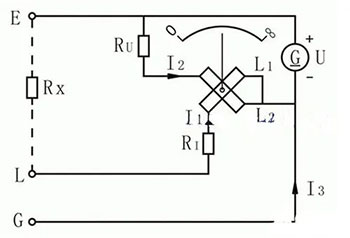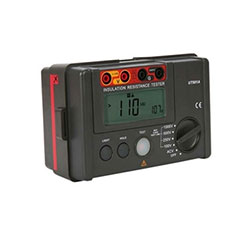What is an Insulation Resistance Tester?
Insulation resistance tester, commonly known as megohmmeter or megger, which is a widely used detection instrument for insulation resistance in power stations and electrical equipment. It is of great significance for ensuring product quality and ensuring personal and equipment safety during operation. The insulation performance of electrical products is one of the important indicators for evaluating their insulation quality, which is reflected through insulation resistance.In this article, ATO industrial automation will introduce the basic information about the insulation resistance tester (including working principle, characteristic and using tips) for you.
Working Principle of Insulation Resistance Tester
The principle of the megohmmeter is based on the relationship between current and voltage. It utilizes Ohm's law, which states that current is equal to the ratio of voltage to resistance. When we connect the megohmmeter to the insulated part of the circuit or equipment to be tested, it applies a certain voltage and measures the current flowing through the insulated part then, according to Ohm's law, we can calculate the value of insulation resistance.
The working principle of megohmmeter can be categorized into two types: DC megohmmeter and AC megohmmeter. A DC megohmmeter measures insulation resistance by applying a DC voltage. It is suitable for measuring the insulation resistance of DC circuits such as DC motors and DC generators. An AC megohmmeter measures insulation resistance by applying an AC voltage. It is suitable for measuring the insulation resistance of AC circuits such as transformers and power lines.
The measurement range of a megohmmeter usually ranges from a few megaohms to up to a few gigabohms. In order to improve the accuracy of measurement, a megohmmeter usually has multiple measurement gears and automatic or manual selection functions. When selecting the measurement gear, we need to make appropriate choices based on the insulation resistance range of the circuit or equipment to be tested. If the selected gear is too small, it will result in inaccurate measurement results; while selecting a gear too large will make the measurement time longer.
Characteristics of Insulation Resistance Tester
- Able to accurately measure lower insulation impedance
The rated output voltage can be maintained as low as 4MΩ/8MΩ/20MΩ for 5400 load resistance, and 20MΩ/40MΩ for 5500 load resistance; For the 5600 model, it is 40MΩ/80MΩ, which allows the instrument to accurately measure lower insulation impedance. - Easy to read
Automatic conversion of high and low range dual scale indication with LED display of corresponding colors.
- Strong anti-interference ability
The entire machine adopts a portable design of ABS plastic casing, with a compact structure and exquisite appearance. - Strong seismic resistance
The instrument adopts an ultra-thin tension wire gauge head. - High output power
Dual purpose AC/DC with built-in rechargeable battery and intelligent charging module.
Notes for Using Insulation Resistance Tester
- Correctly select its voltage and measurement range. For electrical equipment with a voltage range of 50-380 V, a 500 V megohmmeter can be used to check the insulation condition. For electrical equipment below 500 V, a megohmmeter should be selected with readings starting from zero, otherwise it is difficult to measure.
- When selecting external wires for megohmmeters, a single stranded copper wire should be used instead of a double stranded insulated wire. The insulation strength should be above 500 V, otherwise it will affect the accuracy of the measurement.
- When measuring the insulation resistance of electrical equipment, the power supply of the equipment must be disconnected before measurement and it must be verified that there is no electricity. If it is a capacitor or a longer cable line, it should be discharged before measurement.
- The megohmmeter must be kept away from strong magnetic fields and placed flat during use.
- Before measurement, the megohmmeter should undergo an open circuit test first, followed by a short circuit test. The meter needle should point to "∞" (infinity) during the open circuit test, while being able to swing to "O" during the short circuit test indicates that the megohmmeter is working normally and can measure electrical equipment.
- During measurement, the surface of the tested electrical equipment should be cleaned to avoid causing high contact resistance and inaccurate measurement results.
- When measuring the insulation resistance of a capacitor, it should be noted that the withstand voltage of the capacitor must be greater than the voltage value emitted by the megohmmeter. After measuring the capacitance, the wire of the shake meter should be removed first and then the shake handle should be stopped to prevent the charged capacitor from discharging into the shake meter and damaging the instrument. The measured capacitance should be discharged with a resistor.
To summarize, an insulation tester is an instrument used to measure the insulation resistance of an electrical circuit or equipment, and its working principle is based on the relationship between current and voltage. By applying a certain voltage and measuring the current flowing through the insulated part, we can calculate the value of insulation resistance. Insulation testers are widely used in electrical engineering, power industry and electronic equipment maintenance, which can help us to check the insulation quality and find out the problems in time. However, you need to pay attention to the safety matters and choose the right measurement gear when using insulation resistance tester to ensure the accuracy of the measurement results. Through the use of insulation resistance testers, we can improve the reliability of circuits and equipment, to ensure the safe operation of the power system.

